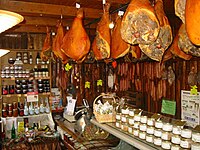
Photo from wikipedia
Processing contributes to different flavors and textures of pork products. However, processing methods have also showed a great impact on meat nutrition. In this study, protein digestibility and digested products… Click to show full abstract
Processing contributes to different flavors and textures of pork products. However, processing methods have also showed a great impact on meat nutrition. In this study, protein digestibility and digested products were compared among four kinds of processed pork products (cooked pork, emulsion-type sausage, dry-cured pork and stewed pork). Cooked samples were homogenized and digested by pepsin and trypsin. The digestibility of meat proteins was evaluated by particle size measurement, SDS-PAGE, and LC-MS/MS. Emulsion-type sausage had the highest digestibility and the lowest particle size (P<0.05), while stewed pork showed the opposite results (P<0.05). Band profiling on SDS-PAGE gels were significantly different before and after digestion, and between pork products as well. LC-MS/MS analysis revealed that stewed pork samples had the greatest number of 750-3500Da Mw peptides in digested products, while emulsion-type sausage had the smallest number of peptides between 750 and 3500Da. Long-time salting and drying, and long-time and high-temperature cooking may induce pork proteins to being less susceptible to pepsin digestion.
Journal Title: Food research international
Year Published: 2017
Link to full text (if available)
Share on Social Media: Sign Up to like & get
recommendations!